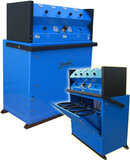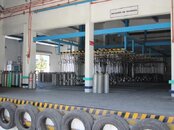Very sad. I have personally filled thousands of tanks over the years and have -fortunately - never had one rupture/explode on me. But I will freely tell you that filling a tank, especially if it's one you don't know (in other words, not yours) can be a scary experience. When I first got certified, I was told the explosive content of a tank under pressure is equivalent to that of two sticks of dynamite. And I certainly wouldn't want to be standing next to two sticks of dynmatie when they went off so that image has stuck with me for close to 40 years now.
Numerous quick thoughts and I'll start here:
Was this a preventable death, or just a freak accident?
Good question and hard to know with the facts as presented. But given the rarity of tank explosions (as mentioned in other comments), my first instinct is that there was something wrong with the tank that could/should have been detected by proper hydro/VIP/eddy test.
Question (and I don't know): Was this a Scuba Club tank (part of their regular rentals) or was it a private (inidivudal's) tank?
Regarding burst discs: They designed to SAFELY vent the air out of the tank. In fact, the whole idea of a burst disc is that it gives way BEFORE the tank explodes and in fact PREVENTS the tank from exploding. So the question here would be why that apparently didn't happen.
As to whether it could have been a hose or compressor part blowing: From the descriptions others have posted about a loud boom, it sure sounds like the tank. From what the doctor said it in the article about multiple metal shards and the amputated limb, it sounds more like a tank. A hose that blows will be loud and whip around (
NOTE: Don't try to catch it while it's doing that) but it's very different.
As to filling in water: It does absolutely nothing except kill you AND get you wet. For years people thought water would help contain the explosive force. It doesn't. All the water does is hopefully keep the tank cool while filling. But if you're over-filling the tank (a possible cause of an explosion) or there's metal fatigue, the water isn't going to help.
As to the concrete tubs: They're not always as strong as they seem and somethimes the explosion tears them apart and then the flying concrete becomes more debris that can kill or maim.
Blast containment: If you really want to follow all the rules, you need a proper blast container to fill the tanks. These are designed to direct blast upwards, away from people, not explode themselves, etc. There are many to choose from but this is what the one from Nuvair looks like. Note that the tanks slide in and then the whole thing closes up. (We use a similar one at the Long Beach Aquarium of the Pacific for our tank fills):

You would also tend to think that if this was the tank exploding, there would be far more damage to the room/building in which the explosion occured due to the force of the blast (and this assumes it happened close to the tanks rated pressure, not early in the process). Anyone have any first-hand info on that?
(Note the phrase is "first-hand" as in "saw it youtrself" as opposed to "someone told me".)
A lot of times, divers don't realize or appreciate how dangerous those metal bombs we strap on our backs can be. While an explosion like this is a tragic but rare occurence, it's also an episode from which we all can learn. If you own a shop where you're doing fills, I'm hoping you'll take a look at your fill station and think if it really meets the don't-kill-people-if-it-explodes standard. And if you're Joe or Jane Diver, maybe give some thought next time to hanging around the fill station while the process is ongoing. There are safer places to be should something go wrong.
- Ken






